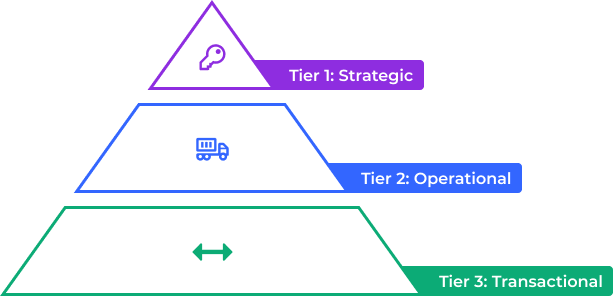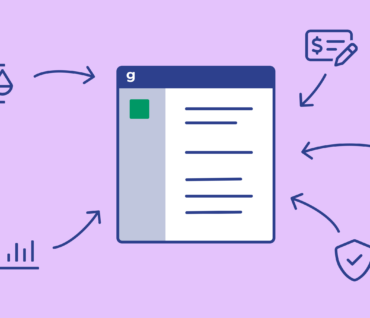
Get Started
Graphite's supplier management tool helps you onboard faster, cut time on risk reviews and streamline supplier validations. Save time and money.
February 8 2023
Supplier Segmentation and Why It Matters
Segmenting suppliers based on their potential business impact is the first step in effectively managing the supplier relationship. By classifying suppliers into distinct groups, procurement professionals can better dedicate the right level of resources to the business partnership.
In other words, which supplier categories does a particular supplier fit in? How important is each supplier to your supply chain? What risks does the supplier pose? Once you understand this, you can tailor your supplier relationships and interactions more efficiently. And to understand this, you need supplier segmentation.
What Is Supplier or Vendor Segmentation?
Supplier segmentation is the strategic process of placing suppliers in categories based on specific criteria like size, risk profile, and importance to your business operations. This helps you better allocate your resources and manage the various types of suppliers with the right level of care.
Supplier segmentation is a vital piece of supplier relationship management and can help to improve the overall efficiency of your supply chain management strategy.
Why Is Supplier Segmentation Important?
No two suppliers are alike, which is why you need a vendor segmentation model to effectively manage them. Those you can identify as key to your business require more engagement than others. By prioritizing suppliers and separating these critical suppliers into groups based on your specific criteria, you can determine the level of attention needed and identify your risk exposure.
Given the pivotal role suppliers play in the overall success of your business, even minor improvements in performance management can lead to major gains in efficiency and profitability for your organization. This nuanced approach to managing diverse supplier relationships is crucial in driving both business continuity and your competitive advantage.
What Are the Key Benefits of Supplier Segmentation?
Vendor or supplier segmentation can unlock several advantages, which are crucial for any enterprise aiming for efficiency and stronger partnerships:
1. Enhanced supplier relationships: Recognizing the varying importance of suppliers in your supply chain is key. Segmenting suppliers helps you focus more on those who are central to your operations, ensuring that your most critical supplier relationships get the attention they deserve.
2. Minimized supplier risk: Different suppliers bring different levels of risk to your business. By segmenting them, you gain clearer insights into these risks, especially for those suppliers integral to your supply chains. This enhanced visibility allows for more effective supplier risk management strategies.
3. Optimized supply chain efficiency: A one-size-fits-all approach doesn’t work in supplier management. With supplier segmentation, you can tailor your strategies to different groups of suppliers. This customization lets you fine-tune your management tactics for optimal results with each supplier, leading to a more efficient supply chain overall.
3 Supplier Categories for your Supplier Segmentation Model
Use the following three key supplier classifications to shape your segmentation strategy–from those strategic suppliers who are pivotal to your business operations to transactional vendors you rely on for short-term needs.
Remember, while these supplier categories are ideal for most businesses, your organization’s unique characteristics may require you to come up with your own supplier categories. It doesn’t matter which vendor segmentation model you follow, so long as your approach is logical, coherent, and suitable for your organization.

Strategic—These key suppliers are critical to your business running smoothly and meeting its core objectives. This level goes beyond cost savings and adds value to your business over the long term. Ask yourself: If this supplier went out of business today, would your organization be able to continue doing business? Strategic suppliers are the most difficult to replace.
Operational—Although not as critical to your organization functioning, these core suppliers are required to sustain daily business needs, but there are alternatives. Examples might include project management, data analysis, or talent acquisition firms. If these suppliers were to go out of business, it would be inconvenient, but you wouldn’t need to panic.
Transactional—These non-critical suppliers deal with short-term needs or one-off procurement of goods or services. Generally, you have plenty of options with limited impact on your supply chain. For instance, a transactional supplier may be someone you use for a one-time engagement, such as an event venue with many options and negligible transition costs.
Emerging—Suppliers who have the potential to critically impact your business but are in a pilot or testing period may fit best into this tier as they wait to move to a more permanent segment.
How to Identify Strategic Suppliers
When it comes to supplier segmentation, the biggest challenge is the identification phase. If you cannot classify your vendors into specific supplier categories, your entire supplier segmentation matrix will fall apart. Fortunately, identifying suppliers is all about asking the right questions. You can identify your key suppliers by answering questions like these:
- Which product depends on this particular supplier’s components?
- How many vendors can supply the same services or products?
- What costs are associated with sourcing products from other vendors?
Once you understand the characteristics of your various suppliers, you can begin categorizing suppliers and assigning them to specific categories.
Vendor Segmentation is Different for Different Organizations
Remember, there is no single approach to supplier segmentation—choose the one that best fits your business objectives. For instance, you can classify a supplier based on any number of quantitative supplier performance metrics, including:
- Lifecycle cost
- Quality
- Time
- Availability
- Transaction volume
- Dependency
- Cost of maintenance and support
- Compliance
Qualitative metrics may include:
- Strategic alignment
- Industry knowledge
- Anticipated future engagement and more
Your industry will influence your approach as well.
It’s essential to be flexible when working with each supplier, tailoring your relationship based on supplier needs and communication styles. Still, having some procurement processes in place for those different kinds of strategic suppliers will strengthen your relationships and your work output.
7 Best Practices in Supplier Segmentation
Effective supplier segmentation is key to managing your supplier base efficiently, enhancing relationship building, and optimizing your supply chain. Consider these best practices to make sure you get the most out of your supplier segmentation process:
1. Embrace the Pareto Principle:
Remember the 80/20 rule—typically, 20% of your suppliers are responsible for 80% of your supply chain value. Focus on identifying and prioritizing this critical 20% to guide your supplier segmentation efforts efficiently.
2. Leverage technology:
Take advantage of supplier management software to streamline the segmentation process. Technology can help you manage key supplier data like risk analyses, spending statistics, and dispute rates, offering a more complete view of each supplier.
3. Incorporate qualitative data:
Don’t just rely on quantitative data such as spending figures. Qualitative aspects like risk assessments, value judgments, and future importance forecasts are crucial in forming a well-rounded segmentation strategy.
4. Share insights across departments:
The insights gained from supplier segmentation are valuable across various departments, from procurement to finance. Engage these teams during the data-collection phase and share the final strategy with them to inform broader supply chain management decisions.
5. Regularly review and update your supplier segmentation model:
Supplier segmentation is not static. Regularly review and update your sourcing strategies to reflect changes in your supplier base, their performance, and risk factors.
6. Take a holistic view:
Look beyond cost. Consider the total value each supplier brings, including delivery performance, compliance, quality, and responsiveness to challenges.
7. Maintain ongoing performance management:
Treat supplier segmentation and performance management as continuous processes. Regularly update your strategies to reflect changes in supplier usage, terms, and overall value.
By following these practices, you’ll maximize efficiency and create a more responsive approach to supplier segmentation that manages costs and provides the best value from your supplier relationships.
Effective Supplier Segmentation = Enhanced Supplier Management
When you take the time to classify your key suppliers into the appropriate tiers, your supplier performance management and reporting will become far more robust and meaningful where it matters most—with your most critical partners. You’ll gain greater visibility into your supply chain by seeing how your top-tier strategic suppliers perform on specific metrics, such as quality, response time, or availability. This deeper transparency allows you to pivot quickly and make necessary changes when issues arise.
Read the Full Ebook
Want to know how to reduce cost and mitigate risk in your own supply chain? Read our Supplier Lifecycle Management ebook.
Read More



